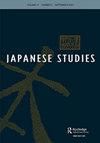Religion, Power, and the Rise of Shinto in Early Modern Japan
IF 0.4
Q3 AREA STUDIES
引用次数: 0
Abstract
Japanese responding to the music of poor Southern Whites, encouraged by the US occupation (152). The ethnographic description shows an insider view, Mitsui having lived through most of the postwar genres dealt with. The final chapter, ‘Domestic Exoticism: A Trend in the Age of “World Music”’ (Mitsui & Hosokawa, 1998) discusses World Music as an ‘Asian turn’, a cultural globalisation in which Japanese began to listen to Asian music. At the same time, Japanese started seeing Okinawan groups such as Rinken Band as exotic and interesting, and seeing mainstream Japanese folk of Itō Takio as exotic, but ‘revved up’. The concluding overview section compares ‘indigenous’ (traditional classical) music with other genres. Mitsui simplistically maintains that traditional music has not been affected by the West and has not changed. The final section of the original overview chapter was a review of publications by non-Japanese, here touched on briefly in footnotes. The overall style of writing is scholarly, but accessible. Expression is sometimes stilted, syntax often awkward, and occasionally impenetrable. It is further marred by occasional misprints. Romanization and use of hyphens are not standard. The book contributes to existing publications on Japanese popular music by dealing in detail with genres that are rarely treated in English scholarship, bringing together in one place significant research by this pioneer of popular Japanese music research. The book is further enriched by a comprehensive list of Japanese and English language entries providing an excellent resource.近代早期日本的宗教、权力与神道教的兴起
日本人响应贫穷的南方白人的音乐,受到美国占领的鼓励(152)。人种学的描述显示了一种内部观点,三井经历了战后处理的大多数流派。最后一章“国内异国情调:“世界音乐时代的趋势”(Mitsui&Hosokawa,1998)将世界音乐讨论为“亚洲转向”,即日本人开始收听亚洲音乐的文化全球化。与此同时,日本人开始认为林肯乐队(Rinken Band)等冲绳团体充满异国情调和有趣,认为日本主流民间的ItōTakio充满异国情调,但“热情高涨”。结语部分将“本土”(传统古典)音乐与其他流派进行了比较。三井简单地认为,传统音乐没有受到西方的影响,也没有改变。最初概述一章的最后一节是对非日本人出版物的回顾,在脚注中简要提及。总体的写作风格是学术性的,但通俗易懂。表达有时很生硬,语法通常很尴尬,有时也很难理解。它因偶尔的印刷错误而进一步受损。罗马化和使用连字符是不标准的。这本书通过详细处理英国学术界很少处理的流派,为现有的日本流行音乐出版物做出了贡献,将这位日本流行音乐研究先驱的重要研究汇集在一起。这本书进一步丰富了日语和英语词条的综合列表,提供了一个极好的资源。
本文章由计算机程序翻译,如有差异,请以英文原文为准。
求助全文
约1分钟内获得全文
求助全文

 求助内容:
求助内容: 应助结果提醒方式:
应助结果提醒方式:


